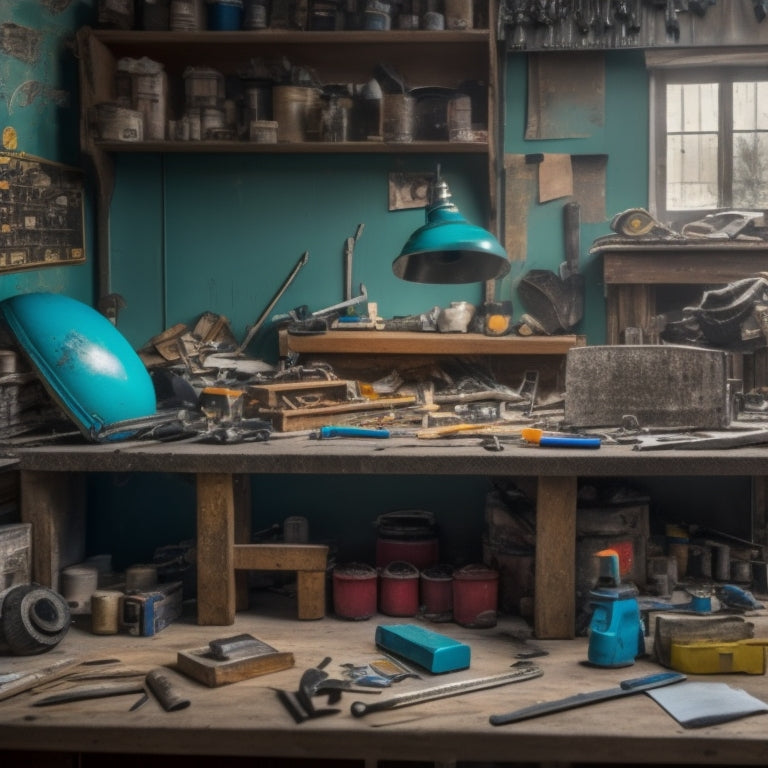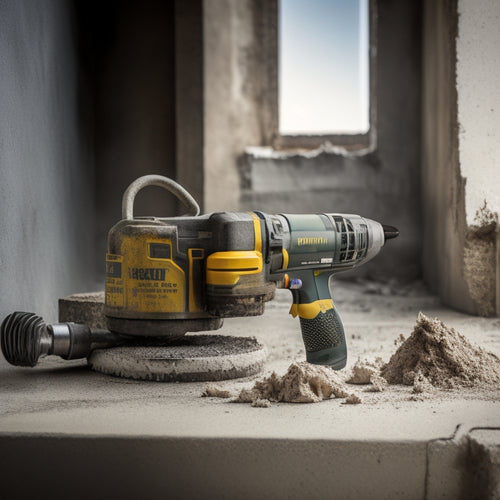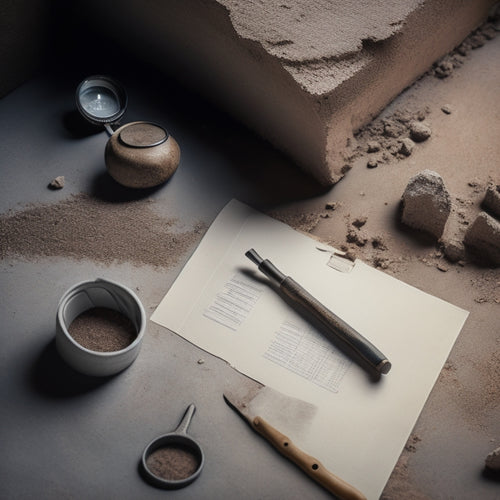
Top 10 Tools for Home Renovation Success
Share
You'll greatly increase the chances of a successful home renovation project by investing in the right tools, as they can make all the difference between a solid foundation and a crumbling structure. Essential tools include concrete mixing buckets, heavy-duty mixing drills, and finishing tools like bull floats and power trowels. Don't forget concrete cutting and drilling tools, like diamond blades and rotary hammer drills, as well as polishing machines and safety gear. Additionally, consider advanced tools for concrete repair, testing, and demolition. By equipping yourself with these must-haves, you'll set your project up for success - and there's more to explore when it comes to taking your renovation to the next level.
Key Takeaways
• Reliable concrete mixing tools, including a sturdy mixing bucket and heavy-duty mixing drill, ensure a strong foundation for renovation projects.
• Right finishing tools, like bull floats and hand floats, achieve smooth, professional-looking concrete finishes.
• High-quality diamond blades are essential for efficient and safe concrete cutting, with different types catering to specific applications.
• Specialized drilling and boring tools, including concrete core drills and rotary hammer drills, enable precise and safe hole creation.
• Concrete grinding and polishing tools, such as grinders and polishers, smooth uneven surfaces and remove coatings to achieve high-gloss finishes.
Essential Concrete Mixing Tools
You'll need a set of reliable concrete mixing tools to guarantee a strong and durable foundation for your home renovation project.
With the right tools, you'll be able to mix concrete efficiently and effectively, making sure of a solid base for your renovation. A sturdy mixing bucket, a heavy-duty mixing drill, and a set of mixing paddles are essentials in your toolbox.
Mastering proper mixing techniques is essential to achieving the perfect consistency and strength. Practice different mixing patterns, such as the 'figure-eight' or 'circles,' to make certain of thorough mixing.
Regular tool maintenance is also important to extend the lifespan of your equipment. Clean your mixing tools thoroughly after each use, and store them in a dry place to prevent rust. Lubricate moving parts to reduce wear and tear.
By investing in quality concrete mixing tools and following proper maintenance routines, you'll be able to tackle your home renovation project with confidence.
With the right tools and techniques, you'll be able to achieve professional-grade results that will last for years to come.
Best Concrete Finishing Equipment
When it comes to achieving a smooth, professional-looking finish on your concrete project, you'll need the right tools for the job.
You're likely wondering which concrete finishing equipment will help you achieve the desired results, and we've taken care of that for you.
Let's take a closer look at the power trowel options and finishing tool essentials that'll make all the difference in your renovation project.
Power Trowel Options
Selecting the right power trowel for your concrete finishing project can greatly impact the quality of your results, saving you time and effort in the long run. You have two primary options to evaluate: manual power trowels and electric power trowels.
Manual power trowels are ideal for small to medium-sized projects, providing a high level of control and precision. They're also more affordable and require less maintenance.
Electric power trowels, on the other hand, are better suited for larger projects, offering increased speed and efficiency. They're perfect for covering vast areas quickly, but may require more skill and practice to master.
When choosing between these options, assess the size of your project, your level of experience, and the desired finish. If you're working on a small, intricate project, a manual power trowel might be the way to go.
For larger, more extensive projects, an electric power trowel could be the better choice. Regardless of which option you select, make sure to choose a high-quality power trowel that meets your specific needs.
Don't be afraid to invest in additional accessories, such as trowel blades or edging tools, to enhance your results.
Finishing Tool Essentials
Concrete finishing requires precision and finesse, which is why having the right finishing tool essentials in your arsenal is crucial for achieving a high-quality, professional-looking result.
As you work on your home renovation, you'll need to master various finishing techniques to get the desired texture and appearance. That's where the right tools come in.
When it comes to texture application, you'll need a range of tools to achieve the perfect finish. A bull float is a must-have for smoothing out freshly poured concrete, while a hand float is ideal for smaller areas and detailed work. A finishing trowel is also necessary for applying textures and patterns to your concrete surface.
Don't forget an edger, which helps create a clean, defined edge around your concrete slab.
Investing in these finishing tool essentials will give you the confidence to tackle even the most complex concrete projects. With the right tools and a bit of practice, you'll be able to achieve professional-looking results that will elevate your home renovation to the next level.
Must-Have Concrete Cutting Tools
When you're tackling a concrete cutting project, you'll need the right tools to get the job done efficiently and safely.
You'll want to contemplate investing in high-quality diamond blade options that can handle the specific type of concrete you're working with.
Additionally, you'll need to think about cutting depth control, which will help you make precise cuts and avoid damaging the surrounding material.
Diamond Blade Options
You'll need to equip yourself with the right diamond blade options to tackle any concrete cutting task efficiently and effectively.
When it comes to diamond blade types, you'll want to take into account the specific application and material you're working with. For example, a segmented diamond blade is ideal for cutting through concrete, asphalt, and stone, while a continuous rim blade is better suited for tile, porcelain, and marble.
It's also critical to maintain your diamond blades to guarantee peak performance and extend their lifespan. Regularly cleaning and inspecting your blades can help prevent damage and clogging. Additionally, you should store them properly to avoid damage and rust.
By choosing the right diamond blade for the job and following proper maintenance procedures, you'll be able to make precise cuts, reduce wear and tear on your equipment, and get the job done quickly and efficiently.
With the right diamond blade options, you'll be well on your way to achieving professional-grade results.
Cutting Depth Control
With your diamond blade options in place, it's time to focus on maintaining precise control over your cuts, and that's where cutting depth control comes in - a must-have concrete cutting tool that helps prevent over-cutting and guarantees a clean, accurate finish.
This feature allows you to set a specific cutting depth, ensuring you don't cut too much or too little. By controlling the cutting depth, you'll achieve professional-looking results and avoid costly mistakes.
When it comes to cutting techniques, having a reliable depth measurement system is essential. This feature enables you to accurately measure the cutting depth, making it easier to achieve precise cuts.
Look for a tool with a built-in depth gauge or a laser guide that projects a precise cutting line onto the material. This will help you maintain a consistent cutting depth, even when working with complex cuts or intricate designs.
Home Renovation Concrete Safety
As you begin working with concrete during your home renovation, it's vital to prioritize safety to avoid injuries and potential long-term health risks. Concrete can be hazardous, especially when you're handling it, cutting it, or drilling into it. That's why it's important to follow concrete safety practices to minimize the risks.
First and foremost, invest in personal protective equipment (PPE) such as gloves, safety glasses, and a dust mask. These will protect you from skin irritation, eye damage, and respiratory problems. Make sure your PPE fits properly and is in good condition.
When handling concrete, avoid touching your face, especially your eyes, and wash your hands thoroughly afterward. Keep your work area clean and well-ventilated to prevent the buildup of dust and debris.
If you're working with power tools, make certain you're using them correctly and following the manufacturer's instructions.
Concrete Drilling and Boring Tools
Frequently, concrete drilling and boring tasks require specialized tools designed to handle the density and hardness of concrete. You'll need the right equipment to get the job done efficiently and safely.
For core drilling, a concrete core drill is a must-have. This tool allows you to create precise holes for pipes, wires, or other installations. When it comes to wall anchors, a rotary hammer drill with a masonry bit is the way to go. This combo enables you to drill into concrete and install anchors for shelves, cabinets, or other heavy objects.
Additionally, a carbide-tipped masonry bit is essential for drilling through concrete, brick, or block. These bits are designed to withstand the high torque and heat generated when drilling through dense materials.
Don't forget to invest in a dust mask and safety goggles to protect yourself from the debris and dust generated during concrete drilling and boring tasks. With the right tools and safety gear, you'll be able to tackle even the toughest concrete projects with confidence.
Top Concrete Grinding Machines
You'll need a reliable concrete grinding machine to smooth out uneven surfaces, remove old coatings, or prepare concrete for finishing. When it comes to concrete grinding techniques, having the right machine makes all the difference. Look for the best concrete grinders that offer high torque, variable speed, and adjustable handlebars for maximum control and comfort.
For heavy-duty grinding, consider machines with 10-12 amps of power and a 5-6 inch grinding path. These machines can handle thick coatings and rough surfaces with ease. If you're working on smaller areas, a 4-5 amp machine with a 3-4 inch grinding path may be more suitable.
Some top-rated concrete grinders include the DeWalt DCG412B, the Bosch CSG15, and the Metabo WEV15-125. These machines are known for their durability, reliability, and ease of use.
When choosing a grinder, consider the surface you're working on, the type of coating or material you're removing, and the level of precision you need. With the right concrete grinder and the right technique, you'll be able to achieve professional-looking results and take your home renovation to the next level.
Concrete Polishing Tool Essentials
When polishing concrete, having the right tools is essential to achieving a high-gloss finish. Investing in a quality concrete polishing tool kit can make all the difference in your home renovation project.
You'll want to start with a reliable concrete polisher, which can handle various polishing techniques and surface types. Look for a polisher with adjustable speed settings and a durable construction to withstand heavy use.
In addition to the polisher, your kit should include a range of diamond abrasives, from coarse to fine grit, to achieve the desired surface shine.
Don't forget to add a set of polishing pads, which can be used to refine the finish and remove any imperfections.
A good quality concrete sealer should also be included to protect the polished surface from stains and damage.
Home Renovation Concrete Testing
Before applying that glossy finish, test your concrete to verify it's strong and durable enough to support your desired renovation. You can't afford to skip this vital step, as subpar concrete can lead to costly repairs or even structural damage. To guarantee a successful renovation, you need to assess the concrete quality using the right testing methods.
Here are three essential concrete testing methods to add to your toolkit:
-
Slump Test: Measures the workability and consistency of fresh concrete, helping you identify potential issues before they become major problems.
-
Compressive Strength Test: Determines the concrete's ability to withstand compressive forces, ensuring it can support the weight and stress of your renovation.
-
Sound Test: Detects any defects or voids within the concrete, allowing you to address them before they compromise the structure's integrity.
Concrete Repair and Patching Tools
When tackling concrete repair and patching projects, you'll need the right tools to get the job done efficiently and effectively.
You'll want to familiarize yourself with crack injection methods, which involve filling cracks with specialized materials to prevent further damage.
Before applying any patches, it's crucial to understand surface preparation essentials, including cleaning and preparing the area to guarantee a strong bond between the old and new concrete.
Crack Injection Methods
You'll need to select the right crack injection method and tools to effectively repair and patch concrete cracks, guaranteeing a strong and durable bond. When it comes to crack injection, you have several options to choose from, each with its own advantages and disadvantages.
Here are three common crack injection methods to assess:
-
Polyurethane Injection: This method involves injecting a polyurethane foam into the crack, which expands to fill the void and provides a strong bond. It's ideal for wet cracks and those with high water flow.
-
Epoxy Injection: This method uses a high-strength epoxy resin to fill the crack, providing a strong and durable bond. It's suitable for dry cracks and those with low water flow.
-
Acrylic Injection: This method involves injecting an acrylic gel into the crack, which hardens to form a strong and flexible bond. It's ideal for cracks with high movement and vibration.
When selecting a crack injection method, evaluate factors such as the type of crack, its location, and the surrounding environment. By choosing the right method and tools, you can guarantee a successful repair that lasts for years to come.
Additionally, understanding crack sealing techniques and foundation repair methods will help you tackle complex projects with confidence.
Surface Preparation Essentials
Proper surface preparation is essential to guaranteeing a strong, long-lasting bond between the old concrete and the new repair material, and that's where the right concrete repair and patching tools come in.
You'll need to assess the substrate to identify any cracks, holes, or weak spots that need attention. This is where surface preparation techniques come into play. You'll need to clean the area thoroughly, removing any dirt, oil, or other substances that might interfere with the repair.
Next, you'll need to roughen the surface to create a strong bond between the old and new concrete. A wire brush or scraper can help with this. For larger areas, consider using a concrete grinder or scarifier to remove old, damaged concrete and create a fresh surface.
Don't forget to vacuum up any debris to guarantee a clean surface for the repair. With the right tools and techniques, you'll be able to create a strong, durable bond that will last for years to come.
Advanced Concrete Demolition Tools
Concrete demolition projects require specialized tools that can efficiently break through and remove thick, reinforced concrete. Advanced concrete demolition tools are designed to make this process faster, safer, and more cost-effective.
You'll need these advanced tools to tackle complex demolition projects, and they'll help you avoid costly delays and injuries.
When it comes to advanced concrete demolition tools, you'll want to evaluate the following:
-
Hydraulic breakers: These powerful tools use hydraulic pressure to deliver high-impact blows, making them ideal for breaking up thick concrete slabs and foundations.
-
Concrete saws: These saws are designed to cut through concrete quickly and efficiently, allowing you to make precise cuts and remove concrete sections with ease.
-
Demolition robots: These remote-controlled machines are perfect for maneuvering tight spaces and performing demolition tasks in areas that are hard to reach.
Frequently Asked Questions
What Is the Best Way to Clean Concrete Tools After Use?
When you're done with your concrete tools, you'll want to clean them properly to maintain their performance.
You're wise to prioritize tool maintenance, as it extends their lifespan.
For effective cleaning techniques, start by scraping off excess concrete with a putty knife or wire brush.
Then, wash the tools with soap and warm water, and dry them thoroughly to prevent rust.
Can I Rent Concrete Renovation Tools Instead of Buying?
Let's say you're renovating a small patio and need a concrete saw for a day. Buying one would set you back $500, but renting it for $50 makes more sense.
You can definitely rent concrete renovation tools instead of buying them, and it's a cost-effective option.
Rental benefits include access to specialized tools without the hefty upfront cost, plus you won't have to worry about storage or maintenance.
How Do I Store Concrete Renovation Tools When Not in Use?
When you're not using your concrete renovation tools, you'll want to store them safely and efficiently.
You're smart to think about tool organization and storage solutions. Designate a specific area, like a shed or garage, and invest in shelving, bins, and hooks.
Label everything so you can find what you need quickly. Keep frequently used tools easily accessible, and store heavier items at the bottom to prevent accidents.
Are Concrete Renovation Tools Suitable for DIY Projects?
Delve into DIY concrete projects with confidence!
You'll find that concrete renovation tools are indeed suitable for your endeavors.
When selecting tools, prioritize durability and versatility.
Choose tools that can tackle tasks efficiently, like a robust drill for mixing and a sturdy trowel for smoothing.
With the right tool selection, you'll be well-equipped to tackle any DIY concrete project that comes your way.
Do I Need Special Training to Use Concrete Renovation Tools?
When working with concrete renovation tools, you'll want to take into account whether you need special training.
While some tools are user-friendly, others require more expertise to guarantee safety and effective use.
You'll need to take safety precautions, like wearing protective gear, and make informed tool selections based on your project's specific needs.
Don't be afraid to seek guidance or online tutorials to boost your confidence and skills.
Conclusion
You've made it to the finish line!
With these top 10 tools for home renovation success, you're ready to tackle any concrete project like a pro.
From mixing to demolition, you've got the essential kit to get the job done.
So, don your hard hat and channel your inner Renaissance master builder - the concrete canvas awaits!
Now, go forth and hammer out a renovation masterpiece that'll make the ages proud!
Related Posts
-

Top Drill for Concrete Wall Renovation
When choosing the top drill for your concrete wall renovation, you'll want to prioritize key features like drill powe...
-

Crack Repair Inspection Checklist for Home Renovation
When creating a crack repair inspection checklist for your home renovation project, you'll want to identify crack typ...
-

Why Renovation Waste Disposal Harms the Environment
When you undertake a renovation project, you're contributing to a staggering problem: renovation waste disposal, whic...


